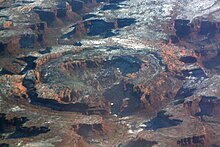Dome (geology)
If the top of a dome has been eroded flat, the resulting structure in plan view appears as a bullseye, with the youngest rock layers at the outside, and each ring growing progressively older moving inwards.
Structural domes can be formed by horizontal stresses in a process known as refolding, which involves the superposition, or overprinting, of two- or more fold fabrics.
[1][3] Diapirism involves the vertical displacement of a parcel of material through overlying strata in order to reach equilibrium within a system that has an established density gradient (see Rayleigh–Taylor instability).
Potential materials comprised by these less-dense strata include salt (which is highly incompressible, thus creating the structural instability that leads to diapirism when buried under deposited strata and subject to overlying stress) and partially melted migmatite (a metamorphic-texture rock frequently found in domes due to the typical involvement of heat and/or pressure with their formation).
[6][7] A complex crater, caused by collision of a hypervelocity body with another larger than itself, is typified by the presence of a dome at the centre of the site of impact.



